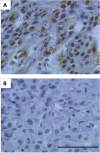p16 (INK4a) has clinicopathological and prognostic impact on oropharynx and larynx squamous cell carcinoma
- PMID: 22948376
- PMCID: PMC3854204
- DOI: 10.1590/s0100-879x2012007500140
p16 (INK4a) has clinicopathological and prognostic impact on oropharynx and larynx squamous cell carcinoma
Abstract
CDKN2A encodes proteins such as p16 (INK4a), which negatively regulate the cell-cycle. Molecular genetic studies have revealed that deletions in CDKN2A occur frequently in cancer. Although p16 (INK4a) may be involved in tumor progression, the clinical impact and prognostic implications in head and neck squamous cell carcinoma (HNSCC) are controversial. The objective of this study was to evaluate the frequency of the immunohistochemical expression of p16 (INK4a) in 40 oropharynx and 35 larynx from HNSCC patients treated in a single institution and followed-up at least for 10 years in order to explore potential associations with clinicopathological outcomes and prognostic implications. Forty cases (53.3%) were positive for p16 (INK4a) and this expression was more intense in non-smoking patients (P = 0.050), whose tumors showed negative vascular embolization (P = 0.018), negative lymphatic permeation (P = 0.002), and clear surgical margins (P = 0.050). Importantly, on the basis of negative p16 (INK4a) expression, it was possible to predict a probability of lower survival (P = 0.055) as well as tumors presenting lymph node metastasis (P = 0.050) and capsular rupture (P = 0.0010). Furthermore, increased risk of recurrence was observed in tumors presenting capsular rupture (P = 0.0083). Taken together, the alteration in p16 (INK4a) appears to be a common event in patients with oropharynx and larynx squamous cell carcinoma and the negative expression of this protein correlated with poor prognosis.
Figures


Similar articles
-
The role of protein p16(INK4a) in glottic laryngeal squamous cell carcinoma.Pathol Oncol Res. 2014 Oct;20(4):909-15. doi: 10.1007/s12253-014-9773-y. Epub 2014 Apr 24. Pathol Oncol Res. 2014. PMID: 24760498
-
Prognostic significance of cell cycle-associated proteins p16, pRB, cyclin D1 and p53 in resected oropharyngeal carcinoma.J Otolaryngol Head Neck Surg. 2018 Sep 6;47(1):53. doi: 10.1186/s40463-018-0298-3. J Otolaryngol Head Neck Surg. 2018. PMID: 30189895 Free PMC article.
-
P16(INK4A) immunostaining is a strong indicator for high-risk-HPV-associated oropharyngeal carcinomas and dysplasias, but is unreliable to predict low-risk-HPV-infection in head and neck papillomas and laryngeal dysplasias.Int J Cancer. 2014 May 1;134(9):2108-17. doi: 10.1002/ijc.28534. Epub 2013 Oct 21. Int J Cancer. 2014. PMID: 24127203
-
Prognostic significance of overexpressed p16(INK4A) in esophageal squamous cell carcinoma: a meta-analysis.Biomark Med. 2016 May;10(5):537-46. doi: 10.2217/bmm-2015-0057. Epub 2016 Apr 13. Biomark Med. 2016. PMID: 27071776 Review.
-
P16INK4a overexpression and survival in osteosarcoma patients: a meta analysis.Int J Clin Exp Pathol. 2014 Aug 15;7(9):6091-6. eCollection 2014. Int J Clin Exp Pathol. 2014. PMID: 25337256 Free PMC article. Review.
Cited by
-
Increased p16 DNA methylation in mouse thymic lymphoma induced by irradiation.PLoS One. 2014 Apr 18;9(4):e93850. doi: 10.1371/journal.pone.0093850. eCollection 2014. PLoS One. 2014. PMID: 24747802 Free PMC article.
-
The role of protein p16(INK4a) in glottic laryngeal squamous cell carcinoma.Pathol Oncol Res. 2014 Oct;20(4):909-15. doi: 10.1007/s12253-014-9773-y. Epub 2014 Apr 24. Pathol Oncol Res. 2014. PMID: 24760498
-
Prognostic Role of p16 in Nonoropharyngeal Head and Neck Cancer.J Natl Cancer Inst. 2018 Dec 1;110(12):1393-1399. doi: 10.1093/jnci/djy072. J Natl Cancer Inst. 2018. PMID: 29878161 Free PMC article.
-
Evidence for different molecular parameters in head and neck squamous cell carcinoma of nonsmokers and nondrinkers: Systematic review and meta-analysis on HPV, p16, and TP53.Head Neck. 2021 Jan;43(1):303-322. doi: 10.1002/hed.26513. Epub 2020 Oct 23. Head Neck. 2021. PMID: 33098216 Free PMC article.
-
Can CAPRIN-1 Be Responsible for the Recurrence Potential of Odontogenic Keratocysts?J Oral Maxillofac Res. 2024 Jun 30;15(2):e4. doi: 10.5037/jomr.2024.15204. eCollection 2024 Apr-Jun. J Oral Maxillofac Res. 2024. PMID: 39139357 Free PMC article.
References
-
- Orlow I, Lacombe L, Hannon GJ, Serrano M, Pellicer I, Dalbagni G, et al. Deletion of the p16 and p15 genes in human bladder tumors. J Natl Cancer Inst. 1995;87:1524–1529. - PubMed
-
- Quelle DE, Ashmun RA, Hannon GJ, Rehberger PA, Trono D, Richter KH, et al. Cloning and characterization of murine p16INK4a and p15INK4b genes. Oncogene. 1995;11:635–645. - PubMed
-
- Takeuchi S, Bartram CR, Seriu T, Miller CW, Tobler A, Janssen JW, et al. Analysis of a family of cyclin-dependent kinase inhibitors: p15/MTS2/INK4B, p16/MTS1/INK4A, and p18 genes in acute lymphoblastic leukemia of childhood. Blood. 1995;86:755–760. - PubMed
-
- Poznic M. Retinoblastoma protein: a central processing unit. J Biosci. 2009;34:305–312. - PubMed
Publication types
MeSH terms
Substances
LinkOut - more resources
Full Text Sources
Miscellaneous

